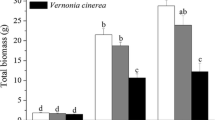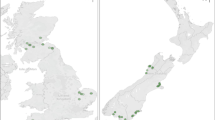Abstract
One particularly compelling explanation for the success of invasive species is the ability to outperform other species in characteristics affecting fitness. Past studies have compared native or introduced non-invasive species to their invasive counterparts, while a system incorporating both native and introduced non-invasive congeners provides an opportunity for multiple controls. We used such a system of Eugenia congeners in Florida to compare seedling performance. In order to determine if invasive Eugenia uniflora seedlings outperform those of its congeners, we sowed seeds in the field and a common garden and quantified seedling emergence, growth, and survival, as well as foliar damage by insect herbivores. We obtained similar results in the field and garden experiments. Although there were no differences in seedling emergence for E. uniflora seedlings when compared to some of its introduced congeners in certain years, emergence of E. uniflora seedlings was consistently high across years. However, emergence, growth, and survival rates of native species were consistently low. In addition, E. uniflora outperformed its introduced and native congeners in growth and survival traits in most comparisons, even when sustaining higher levels of herbivore damage by an introduced weevil, Myllocerus undatus Marshall. Our results support our predictions, indicating that invasive E. uniflora may possess a competitive advantage because its seedlings perform better than or equivalently to its congeners in all of the attributes quantified. Our study further suggests that measurements of such traits may be useful in determining the likelihood of invasion by newly introduced woody plant species.








Similar content being viewed by others
References
Andrade ACS, Cunha R, Souza AF, Reis RB, Almeida KJ (2003) Physiological and morphological aspects of seed viability of a neotropical savannah tree, Eugenia dysenterica DC. Seed Sci Technol 31:125–137
Baskin CC, Baskin JM (1998) Seeds ecology, biogeography, and evolution of dormancy and germination. Academic Press, San Diego
Bates D, Maechler M, Bolker B (2011) lme4: linear mixed-effects models using S4 classes. R package version 0.999375-42. http://CRAN.R-project.org/package=lme4
Bohl Stricker KR, Stiling P (2012) Herbivory by an introduced Asian weevil negatively affects population growth of an invasive Brazilian shrub in Florida. Ecology 93:1902–1911
Cahill JF, Kembel SW, Lamb EG, Keddy PA (2008) Does phylogenetic relatedness influence the strength of competition among vascular plants? Perspect Plant Ecol Evol Syst 10:41–50
Colautti RI, Ricciardi A, Grigorovich IA, MacIsaac HJ (2004) Is invasion success explained by the enemy release hypothesis? Ecol Lett 7:721–733
Colautti RI, Grigorovich IA, MacIsaac HJ (2006) Propagule pressure: a null model for biological invasions. Biol Invasions 8:1023–1037
Cox DR (1972) Regression models and life tables (with discussion). J Roy Stat Soc B 34:187–220
Daehler CC (2003) Performance comparisons of co-occurring native and alien invasive plants: implications for conservation and restoration. Annu Rev Ecol Evol Syst 34:183–211
Dostal P (2010) Post-dispersal seed mortality of exotic and native species: effects of fungal pathogens and seed predators. Basic Appl Ecol 11:676–684
Florida Exotic Pest Plant Council (FLEPPC) (2011) FLEPPC 2011 List of invasive plant species—Summer/Fall 2011. http://www.fleppc.org/list/11list.html
Gann GD, Bradley KA, Woodmansee SW (2007) The floristic inventory of South Florida Database Online. The Institute for Regional Conservation, Miami. http://www.regionalconservation.org/ircs/database/plants/PlantPage.asp?TXCODE=Eugenunif
Gilman EF (2011)a Eugenia axillaris. Fact Sheet FPS-199. Environmental Horticulture Department, Cooperative Extension Service, Institute of Food and Agricultural Sciences, University of Florida
Gilman EF (2011)b Eugenia foetida. Fact Sheet FPS-200. Environmental Horticulture Department, Cooperative Extension Service, Institute of Food and Agricultural Sciences, University of Florida
Global Invasive Species Database (2006) Eugenia uniflora. http://www.issg.org/database/species/distribution.asp?si=983&fr=1&sts=sss&lang=EN
Goodwin BJ, McAllister AJ, Fahrig L (1999) Predicting invasiveness of plant species based on biological information. Conserv Biol 13:422–426
Gordon DR, Thomas KP (1997) Florida’s invasion by nonindigenous plants: history, screening, and regulation. In: Simberloff D, Schmitz DC, Brown TC (eds) Strangers in paradise: impact and management of nonindigenous species in Florida. Island Press, Washingon, DC, pp 21–38
Grotkopp E, Rejmánek M (2007) High seedling relative growth rate and specific leaf area are traits of invasive species: phylogenetically independent contrasts of woody angiospernis. Am J Bot 94:526–532
Hamilton MA, Murray BR, Cadotte MW, Hose GC, Baker AC, Harris CJ, Licari D (2005) Life-history correlates of plant invasiveness at regional and continental scales. Ecol Lett 8:1066–1074
Hothorn T, Bretz F, Westfall P (2008) Simultaneous inference in general parametric models. Biometrical J 50(3):346–363
Howard RA (1989) Flora of the Lesser Antilles Leeward and Windward Islands Volume 5. Arnold Arboretum, Harvard University, Jamaica Plain, Massachusetts
Keane RM, Crawley MJ (2002) Exotic plant invasions and the enemy release hypothesis. Trends Ecol Evol 17:164–170
Lake JC, Leishman MR (2004) Invasion success of exotic plants in natural ecosystems: the role of disturbance, plant attributes and freedom from herbivores. Biol Conserv 117:215–226
Levine JM, Adler PB, Yelenik SG (2004) A meta-analysis of biotic resistance to exotic plant invasions. Ecol Lett 7:975–989
Liu H, Stiling P (2006) Testing the enemy release hypothesis: a review and meta-analysis. Biol Invasions 8:1535–1545
Liu H, Stiling P, Pemberton RW, Pena J (2006) Insect herbivore faunal diversity among invasive, non-invasive and native Eugenia species: implications for the enemy release hypothesis. Fla Entomologist 89:475–484
Lonsdale WM (1999) Global patterns of plant invasions and the concept of invasibility. Ecology 80:1522–1536
Masetto TE, Faria JMR, Davide AC, Da Silva EAA (2008) Desiccation tolerance and DNA integrity in Eugenia pleurantha O. Berg (Myrtaceae) seeds. Revista Brasileira de Sementes 30:51–56
Morton J (1987) Fruits of Warm Climates. Julia F. Morton, Miami, Florida
Myers RL, Ewel JJ (1990) Ecosystems of Florida. University of Central Florida Press, Orlando
O’Brien CW, Haseeb M, Thomas MC (2006) Myllocerus undecimpustulatus undatus Marshall (Coleoptera: Curculionidae), a recently discovered pest weevil from the Indian subcontinent. Florida Department of Agriculture and Consumer Services, Division of Plant Industry. Entomology Circular No. 412: 1–4
Pemberton RW, Liu H (2009) Marketing time predicts naturalization of horticultural plants. Ecology 90:69–80
Perglova I, Pergl J, Skalova H, Moravcova L, Jarosik V, Pyšek P (2009) Differences in germination and seedling establishment of alien and native Impatiens species. Preslia 81:357–375
Phillips RL (1994) Selected Eugenia species. University of Florida IFAS Extension HS41. http://edis.ifas.ufl.edu/pdffiles/MG/MG04400.pdf
Pyšek P, Richardson DM (2007) Traits associated with invasiveness in alien plants: where do we stand? In: Nentwig W (ed) Biological invasions. Springer, New York, pp 97–125
Pyšek P, Prach K, Šmilauer P (1995) Relating invasion success to plant traits: an analysis of Czech alien flora. In: Pyšek P, Prach K, Rejmánek M, Wade M (eds) Plant invasions: general aspects and special problems. SPB Academic, Amsterdam, pp 39–60
Pyšek P, Jarosik V, Pergl J, Randall R, Chytry M, Kuhn I, Tichy L, Danihelka J, Chrtek JJ, Sadlo J (2009) The global invasion success of Central European plants is related to distribution characteristics in their native range and species traits. Divers Distrib 15:891–903
R Development Core Team (2012) R: a language and environment for statistical computing. R Foundation for Statistical Computing, Vienna. ISBN 3-900051-07-0
Reichard SH, Hamilton CW (1997) Predicting invasions of woody plants introduced into North America. Conserv Biol 11:193–203
Rejmánek M (2000) Invasive plants: approaches and predictions. Austral Ecol 25:497–506
Simberloff D (2009) The role of propagule pressure in biological invasions. In: Annual Review of Ecology Evolution and Systematics. Annual Reviews, Palo Alto, pp 81–102
Staples GW, Herbst DR (2005) Tropical garden flora: Plants cultivated in the Hawaiian Islands and other tropical places. Bishop Museum Press, Honolulu
Sutherland S (2004) What makes a weed a weed: life history traits of native and exotic plants in the USA. Oecologia 141:24–39
Therneau T, Lumley T (2009) Survival: survival analysis, including penalized likelihood. R package version 2.35–8. http://CRAN.R-project.org/package=survival
Therneau T (2011) Coxme: mixed effects Cox models. R package version 2.1–3. http://CRAN.R-project.org/package=coxme
van Kleunen M, Weber E, Fischer M (2010) A meta-analysis of trait differences between invasive and non-invasive plant species. Ecol Lett 13:235–245
Vila M, Weiner J (2004) Are invasive plant species better competitors than native plant species? Evidence from pair-wise experiments. Oikos 105:229–238
Warton DI, Hui FKC (2011) The arcsine is asinine: the analysis of proportions in ecology. Ecology 92
Acknowledgments
We thank Plantation Heritage Park and the University of South Florida Botanical Gardens staff for providing experimental space over several years. We also thank Hong Liu and Robert Pemberton for inspiring this study, Russ Mapp, Mark Foley, Hugh Taylor Birch State Park, Patrick Griffith, and Montgomery Botanical Center for providing housing accommodations, Heather Jezorek and Diane Harshbarger for field assistance, and Gordon Fox and Jason Rohr for statistical expertise. This work was supported in part by the Florida Exotic Pest Plant Council (FLEPPC) and the Fern Garden Club of Odessa.
Author information
Authors and Affiliations
Corresponding author
Rights and permissions
About this article
Cite this article
Bohl Stricker, K., Stiling, P. Seedlings of the introduced invasive shrub Eugenia uniflora (Myrtaceae) outperform those of its native and introduced non-invasive congeners in Florida. Biol Invasions 15, 1973–1987 (2013). https://doi.org/10.1007/s10530-013-0425-z
Received:
Accepted:
Published:
Issue Date:
DOI: https://doi.org/10.1007/s10530-013-0425-z




